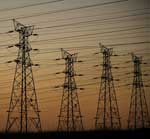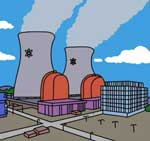 Nice to see the progressive community here in New Mexico heading to the Roundhouse today to protest Senate Joint Memorial 38, which calls for nuclear energy to be declared “green”. As repulsive as it is to see another attempt to dress nukes up as green energy, there are three energy bills sailing through the legislature unnoticed that have far greater consequences for the future of nuclear energy in New Mexico.
Nice to see the progressive community here in New Mexico heading to the Roundhouse today to protest Senate Joint Memorial 38, which calls for nuclear energy to be declared “green”. As repulsive as it is to see another attempt to dress nukes up as green energy, there are three energy bills sailing through the legislature unnoticed that have far greater consequences for the future of nuclear energy in New Mexico.
To really understand how bad these bills are, it helps to first be aware that billions of dollars worth of new transmission projects are being planned in the Southwest to support the hundreds of new nuclear reactors that are on the drawing board across the country. Most of the projects are cloaked in green language and being promoted as clean. Here’s a sampling of some of the worst bills this year, along with a couple of bad memorials:
Senate Bill 190 – William Payne. This bill declares that third-party developers of renewable energy projects are not public utilities subject to regulation, but in doing so it strategically avoids addressing cogeneration projects -- leaving them in limbo with the courts. Worse, it requires the commission to give utilities cost recovery (“shall approve...rate riders”) for all the nasty things utilities always claim happen when renewables are connected to their grid: problems with frequency and voltage regulation, necessity to maintain reserve power for when the sun goes behind a cloud or the wind stops blowing – the usual lies. When it comes to accounting for the benefits created when distributed renewables are connected to the grid, the “shall” language is conspicuously absent and the commission is only required to “give due consideration” to them. How sweet!
House Bill 85 – John Heaton. This bill changes the procedure by which new transmission projects are approved, as well as the standard by which their costs can be passed along to ratepayers. It even allows the commission to bypass the public hearing process on transmission projects, assuming nobody complains (or finds out).
House Bill 98 – Jose Campos. As if the Renewable Energy Transmission Authority (RETA) wasn’t powerful enough, this bill gives it access to the Public Project Revolving Fund and exempts it from the Inspection of Public Records Act. RETA already has, from prior legislation, the right to designate transmission corridors, condemn and seize property through eminent domain, issue bonds without limit, and set (transmission) rates without hearings. It was also declared exempt from all state laws except one: the tort law (it can’t be sued). Seems like a lot more power than you would need for building renewable energy projects. RETA has always been a cover for building nukes. I can’t believe how gullible we are – why would renewables need transmission lines?
House Joint Memorial 35 – Janice Arnold-Jones. As a memorial it doesn’t carry the force of law, but this bill takes the first step towards saddling New Mexico ratepayers with billions of dollars in costs for new transmission projects, including Tres Amigas. Tres Amigas is a multi-billion dollar scheme to connect the three major U.S. power grids together with a DC tie in Clovis, New Mexico. This will enable nuclear power plants built nearby to access all three major U.S. power markets. The claim, of course, is that its purpose is to help us sell renewable energy to California. They have sunshine there too, no? Seems funny to bottle it and ship it to them fromhere, but an awful lot of people are drinking that Kool-Aid.
Senate Joint Memorial 41 – John Heaton. Again no force of law, but this memorial requests that Bill Richardson includes nuclear energy as a central component of his clean energy policy initiatives. Reference my article from last week that showed that at least 27 of the 65 nuclear power plant sites in the U.S. are now leaking radioactive Tritium into the ground water. When nukes are believed to be clean...uh...Houston, we have a problem.
As you can probably tell, I'm not a big fan of our state's legislative process!
To read the bills for yourself, visit the New Mexico Legislature website.
 Sunday, April 18, 2010 at 10:56PM
Sunday, April 18, 2010 at 10:56PM  Mark Sardella will be teaching the fundamentals of how to make commercial buildings more energy efficient this Friday, April 23, 2010, at the new American Solar Energy Institute office in Albuquerque. We'll cover commercial energy audits and assessments, and then I'll show how to benchmark a building using Portfolio Manager -- the EPA's online rating tool used to qualify buildings for the Energy Star Commercial certification. We'll discuss the most common opportunities for savings, how to evaluate their financial return, and how to drive down a carbon footprint with on-site energy.
Mark Sardella will be teaching the fundamentals of how to make commercial buildings more energy efficient this Friday, April 23, 2010, at the new American Solar Energy Institute office in Albuquerque. We'll cover commercial energy audits and assessments, and then I'll show how to benchmark a building using Portfolio Manager -- the EPA's online rating tool used to qualify buildings for the Energy Star Commercial certification. We'll discuss the most common opportunities for savings, how to evaluate their financial return, and how to drive down a carbon footprint with on-site energy.









